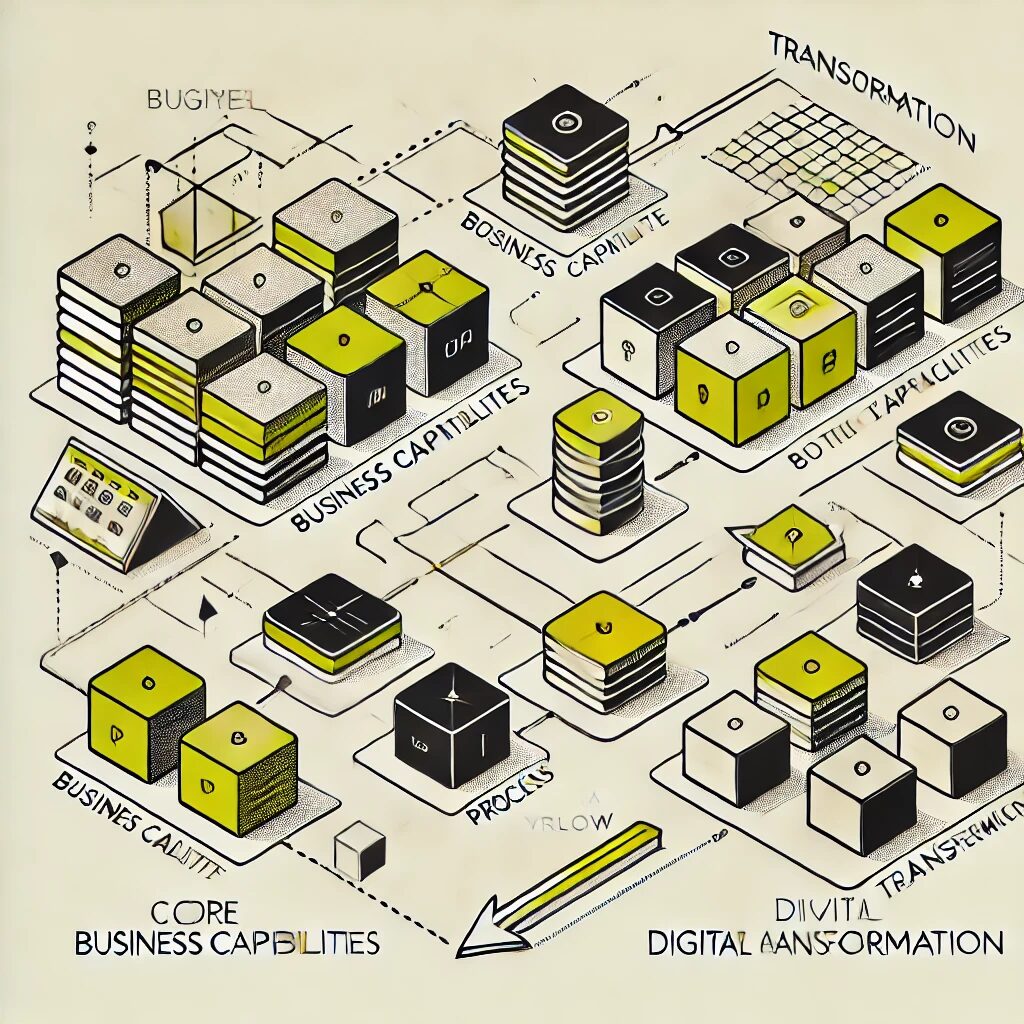
Enterprise Architecture for Powering Utility Digital Transformation. Architecting the Grid of Tomorrow, Today
The utilities sector stands at a pivotal crossroads. Faced with aging infrastructure, rising customer expectations, renewable energy integration, regulatory pressures, and emerging competitors, utilities must fundamentally reimagine their operations and business models. Digital transformation offers the path forward, but without a coherent enterprise architecture foundation, these initiatives risk becoming disconnected technology projects rather than strategic business enablers.
Enterprise Architecture (EA) provides the essential blueprint connecting business strategy and technology execution. By creating a holistic view of business capabilities, information flows, applications, and technology infrastructure, EA ensures digital investments deliver meaningful business outcomes while managing complexity, reducing risk, and enabling the agility utilities need to thrive in an increasingly dynamic environment.
1: The Digital Imperative for Utilities
The utilities sector faces unprecedented disruption that demands a comprehensive digital response. This transformation isn’t optional—it’s essential for survival and relevance.
- Customer Expectations: Today’s utility customers expect the same digital experience they receive from banks, retailers, and other service providers, with personalized, mobile-first, real-time interactions.
- Grid Evolution: The transition from centralized generation to distributed, intermittent resources requires intelligent, responsive grid operations enabled by advanced digital technologies.
- Operational Efficiency: In a regulated environment with constrained revenue growth, utilities must leverage digital technologies to dramatically improve operational efficiency and asset performance.
- New Competition: Alternative energy providers, community choice aggregators, and technology companies are challenging traditional utility business models with digital-native offerings.
- Workforce Transformation: As experienced workers retire, utilities must capture institutional knowledge and attract digital talent through modernized systems and ways of working.
2: Enterprise Architecture: The Digital Transformation Foundation
Enterprise Architecture provides the essential framework that connects business vision to technology execution. This holistic approach ensures digital initiatives deliver meaningful business outcomes.
- Strategic Alignment: Enterprise Architecture establishes clear traceability from business strategy to the capabilities, processes, information, applications, and technologies that enable it.
- Complexity Management: EA creates a structured approach to managing the inherent complexity of utility technology landscapes, reducing redundancy and technical debt.
- Change Enablement: A robust EA practice helps utilities navigate transformational change by providing the blueprints, roadmaps, and governance needed for coordinated evolution.
- Risk Mitigation: EA helps identify and address technology risks, dependencies, and constraints that could derail transformation initiatives or compromise operational resilience.
- Investment Optimization: By mapping technologies to business capabilities, EA helps utilities prioritize investments that deliver the greatest strategic value and retire systems that no longer serve the business.
Did You Know:
- According to a 2023 American Public Power Association study, utilities with mature Enterprise Architecture practices reported 36% higher success rates for digital transformation initiatives and 28% lower technology total cost of ownership compared to peers without established EA functions.
3: The Four Domains of Utility Enterprise Architecture
A comprehensive Enterprise Architecture framework for utilities encompasses four interrelated domains that collectively define the organization’s current and future state.
- Business Architecture: This domain defines what the utility does through capability models, value streams, information requirements, and organizational models independent of how these functions are performed.
- Information Architecture: This domain establishes how the utility organizes, integrates, and governs its critical data assets to support decision-making and operations across the enterprise.
- Application Architecture: This domain defines the systems landscape, integration patterns, and application lifecycle management approaches needed to enable business capabilities.
- Technology Architecture: This domain establishes the infrastructure foundation, from networks and computing platforms to cybersecurity frameworks and operational technology environments.
4: Business Architecture for Utility Transformation
Business Architecture forms the critical bridge between strategic intent and technology execution, ensuring digital investments deliver meaningful business outcomes.
- Capability Mapping: Comprehensive documentation of what the utility does (or should do) creates a stable reference model for aligning transformation initiatives to business needs.
- Value Stream Definition: End-to-end value stream mapping reveals operational friction points and digital enhancement opportunities that transcend organizational silos.
- Information Requirements: Business Architecture defines the critical information assets needed to enable key capabilities, forming the foundation for effective data governance.
- Operating Model Evolution: Clear articulation of how capabilities, processes, and organizational structures must evolve provides the blueprint for comprehensive transformation.
- Strategic Alignment: Business Architecture ensures technology investments directly support strategic objectives by creating clear traceability from business outcomes to enabling technologies.
5: Information Architecture for Data-Driven Utilities
Information Architecture establishes how utilities organize, integrate, and leverage their most valuable asset—data—to drive better decisions and enable digital capabilities.
- Enterprise Data Model: A comprehensive data model defines the utility’s critical information entities, their attributes, and relationships, creating a common vocabulary across the enterprise.
- Data Governance Framework: Clear data ownership, quality standards, security controls, and lifecycle management ensure information can be trusted for critical decision-making.
- Integration Strategy: A well-defined integration architecture establishes how data flows across operational systems, enterprise applications, analytics platforms, and external partners.
- Real-time Analytics Enablement: Information Architecture defines how utilities capture, process, and leverage real-time data from grid sensors, smart meters, and other operational systems.
- Master Data Management: Consistent management of core data entities—customers, assets, locations, meters—creates the foundation for accurate reporting and process integration.
6: Application Architecture for Utility Modernization
Application Architecture defines the systems landscape, integration patterns, and lifecycle management approaches needed to enable business capabilities while managing complexity.
- Application Portfolio Rationalization: Mapping applications to business capabilities reveals redundancies, gaps, and modernization priorities to optimize the systems landscape.
- Integration Architecture: Well-defined integration patterns and technologies ensure applications can share information efficiently across traditionally siloed domains.
- Cloud Strategy: A clear cloud adoption framework guides decisions about which workloads should move to cloud environments and with what deployment models.
- Application Lifecycle Management: Consistent approaches to application development, maintenance, and retirement help utilities manage technical debt and optimize technology investments.
- Digital Platform Definition: Enterprise application architecture defines the common platforms, services, and APIs that accelerate delivery of digital capabilities across the organization.
7: Technology Architecture for Resilient Utility Operations
Technology Architecture establishes the infrastructure foundation that supports applications, enables information sharing, and ensures secure, reliable operations.
- Infrastructure Modernization: A clear roadmap for evolving computing, storage, and network infrastructure supports the growing demands of digital operations and analytics.
- OT/IT Convergence: Technology architecture defines secure approaches for integrating operational technology environments with enterprise IT to enable advanced grid operations.
- Cybersecurity Framework: Comprehensive security architecture protects both information and operational technologies from evolving threats while enabling necessary business flexibility.
- Hybrid Cloud Infrastructure: Technology architecture defines how on-premises, private cloud, and public cloud environments work together to optimize performance, cost, and resilience.
- Technical Standards: Clear technology standards promote consistency, interoperability, and sustainability across the infrastructure landscape.
8: Grid Modernization Through Enterprise Architecture
Grid modernization programs benefit significantly from enterprise architecture approaches that connect physical infrastructure to digital capabilities and business outcomes.
- Smart Grid Reference Architecture: A comprehensive reference architecture connects operational technology, information technology, and business domains to guide grid modernization investments.
- ADMS Implementation Framework: Enterprise architecture provides the blueprint for implementing Advanced Distribution Management Systems that integrate traditionally separate grid management functions.
- Grid Analytics Architecture: A structured approach to grid data integration, storage, and analytics accelerates the deployment of predictive maintenance, outage management, and optimization capabilities.
- DER Integration Architecture: Enterprise architecture defines how distributed energy resources connect to grid management systems, creating a flexible framework for evolving integration needs.
- Grid Resilience Architecture: A holistic view of physical and digital systems supports the design of grid architectures that maintain reliability despite physical disruptions and cyber threats.
9: Customer Experience Transformation
Enterprise architecture approaches help utilities reimagine customer experiences by connecting customer journeys to enabling technologies and business capabilities.
- Digital Customer Architecture: A comprehensive framework connects customer-facing channels to core systems, ensuring consistent experiences across touchpoints and transactions.
- Omnichannel Integration: Enterprise architecture ensures customer information and transactions flow seamlessly across web, mobile, IVR, and traditional channels through shared services and APIs.
- Customer Data Platform: Architecture defines how utilities integrate customer data across systems to create unified profiles that enable personalized experiences and insights.
- Self-Service Enablement: A structured architecture for customer self-service capabilities ensures secure, responsive experiences that integrate with core business processes.
- Customer Analytics: Enterprise architecture establishes how customer data flows into analytics environments to enable behavioral insights, segmentation, and predictive capabilities.
Did You Know:
- A 2024 report by the Electric Power Research Institute found that OT/IT convergence initiatives guided by enterprise architecture frameworks reduced system integration costs by an average of 42% and accelerated deployment timelines by 37% compared to traditional siloed approaches.
10: Operational Excellence Through Digital Twins
Digital twin initiatives benefit from enterprise architecture approaches that integrate physical asset models with enterprise data and analytics capabilities.
- Digital Twin Architecture: Enterprise architecture defines how physical asset models, operational data, enterprise information, and simulation capabilities connect to create comprehensive digital twins.
- Asset Lifecycle Integration: Architecture ensures digital twins connect to enterprise asset management, work management, and financial systems to optimize lifecycle decisions.
- Operational Technology Integration: A well-designed architecture securely connects OT systems with enterprise platforms to enable digital twin capabilities without compromising critical infrastructure.
- Analytics Framework: Enterprise architecture establishes how digital twin data flows into analytics environments to enable predictive maintenance, operational optimization, and investment planning.
- Visualization Standards: Architecture defines consistent approaches for visualizing digital twin information across platforms, ensuring usability across operations, engineering, and planning functions.
11: Enterprise Architecture Governance for Utilities
Establishing effective EA governance ensures architecture remains relevant, valuable, and impactful throughout the transformation journey.
- Architecture Review Board: A cross-functional board with representation from business, operations, IT, and security ensures architecture decisions balance enterprise needs with domain-specific requirements.
- Architecture Principles: Clear, actionable principles guide decision-making across the organization, ensuring individual initiatives contribute to the desired enterprise architecture.
- Technology Standards Management: Consistent processes for defining, communicating, and evolving technology standards promote reuse, interoperability, and sustainable technology choices.
- Architecture Compliance: Lightweight but effective compliance processes ensure significant investments and initiatives align with enterprise architecture direction without creating bureaucratic barriers.
- Value Measurement: Regular assessment of architecture practice impact on business outcomes, project success, and technology economics demonstrates EA value and guides practice evolution.
12: Cloud Adoption Through Enterprise Architecture
Enterprise architecture provides the essential framework for successful cloud adoption that balances agility, security, compliance, and economic value.
- Cloud Reference Architecture: A comprehensive reference architecture defines how cloud platforms integrate with on-premises systems, establishing patterns for hybrid and multi-cloud deployments.
- Workload Placement Framework: Architecture-driven criteria guide decisions about which applications and services should operate in public cloud, private cloud, or traditional environments.
- Cloud Security Architecture: Enterprise architecture establishes security controls, identity management, and data protection approaches that maintain compliance in cloud environments.
- Cloud Operating Model: Architecture defines how cloud governance, operations, financial management, and service delivery models evolve to capture cloud benefits.
- Application Modernization Patterns: Enterprise architecture provides patterns for different modernization approaches from lift-and-shift to refactoring to complete redevelopment based on application characteristics.
13: Analytics & AI Enablement
Enterprise architecture creates the foundation for advanced analytics and artificial intelligence capabilities that drive operational and customer value.
- Data & Analytics Architecture: A comprehensive architecture connects operational data sources, data integration, storage platforms, and analytics capabilities into a coherent ecosystem.
- AI/ML Platform Strategy: Enterprise architecture defines standards and patterns for developing, deploying, and managing AI/ML models across the organization.
- Use Case Prioritization: Architecture-driven assessment helps utilities prioritize analytics and AI use cases based on data readiness, technical feasibility, and business impact.
- Data Science Environment: Architecture establishes secure, scalable environments where data scientists can develop and test models with appropriate access to enterprise data.
- Model Operations: Enterprise architecture defines how AI/ML models move from development to production, including testing, deployment, monitoring, and lifecycle management.
14: Enterprise Architecture Maturity Journey
Developing enterprise architecture capabilities is an evolutionary journey that delivers increasing value as maturity grows across key dimensions.
- Current State Assessment: Begin with an honest evaluation of existing architecture maturity to identify strengths to leverage and gaps to address through targeted improvement.
- Quick Win Identification: Focus initial architecture efforts on high-visibility business challenges where architecture can demonstrate tangible value through improved decision-making.
- Capability Building: Develop both the architecture artifacts and the organizational capabilities needed to create and use them effectively through targeted hiring, training, and processes.
- Tool Strategy: Implement appropriate architecture tools that improve collaboration, communication, and analysis without creating excessive documentation overhead.
- Continuous Evolution: Regularly assess architecture practice effectiveness against changing business needs, ensuring the function remains relevant and valuable to the organization.
Takeaway
Enterprise Architecture provides the foundation for successful utility digital transformation by creating a coherent blueprint connecting strategy to execution. Through integrated business, information, application, and technology architectures, utilities can navigate complex changes with greater confidence and success. The EA approach ensures technology investments align with business priorities, information flows effectively across traditional silos, and technical complexity remains manageable despite accelerating change. Most importantly, enterprise architecture helps utilities maintain operational excellence throughout their transformation journey by providing a stable framework for evolution rather than disruption. As utilities face increasing pressure to digitalize while maintaining reliability, affordability, and security, a mature enterprise architecture practice becomes not just valuable but essential.
Next Steps
- Assess Your Architecture Maturity: Conduct an honest assessment of your utility’s enterprise architecture capabilities, identifying strengths to leverage and critical gaps to address.
- Connect Architecture to Strategy: Ensure your architecture efforts directly support strategic priorities by creating clear traceability from business objectives to architecture decisions.
- Focus on Critical Domains: Identify and prioritize architecture domains with the greatest impact on current transformation initiatives, whether grid modernization, customer experience, or operational optimization.
- Establish Lightweight Governance: Implement governance mechanisms that promote architecture alignment without creating bureaucratic barriers to innovation and execution.
- Build Business Partnership: Position architecture as a business enabler by focusing on business outcomes rather than technical elegance and involving business stakeholders in architecture decisions.
- Start Small, Deliver Value: Begin with focused architecture efforts that address immediate business challenges rather than attempting comprehensive documentation before delivering tangible value.



